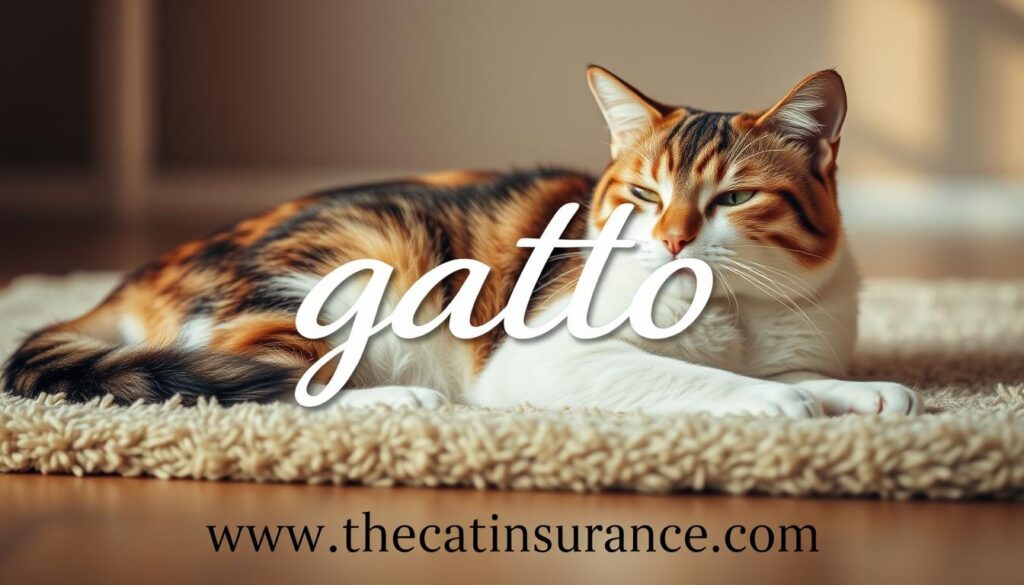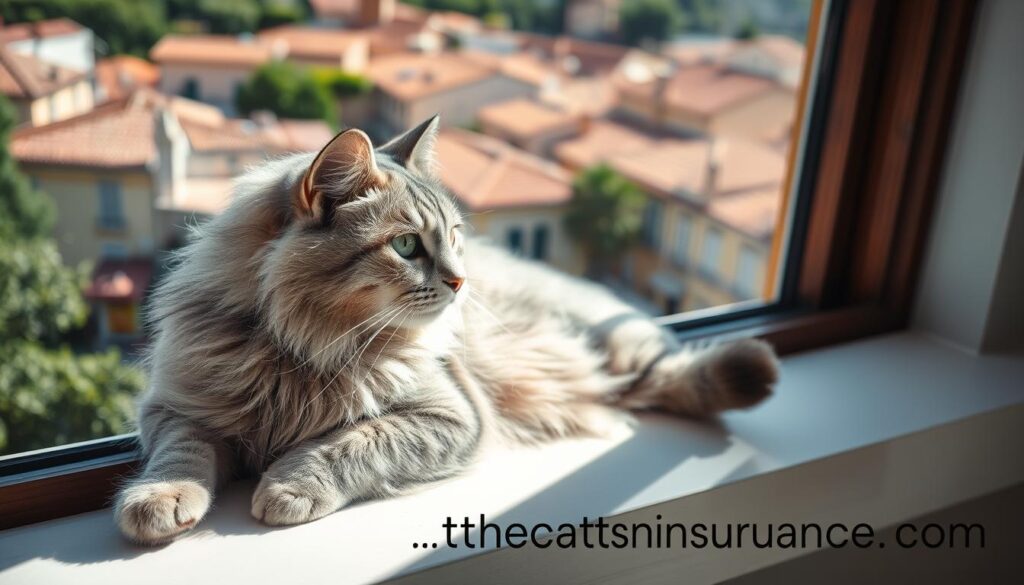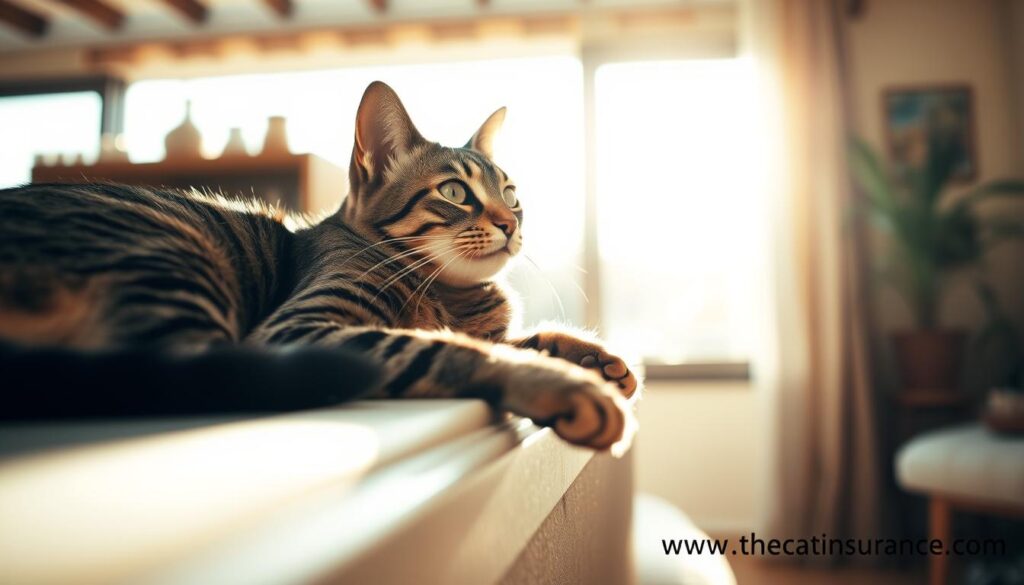Are you a cat lover looking to learn more languages? Maybe you’re planning a trip to a Spanish-speaking country. You want to impress the locals with your Spanish skills.
Learning to say “cat” in Spanish is a great start. The Spanish word for cat is “gato.” You can find pronunciation guides and language learning resources at Speak Languages Better to help you master the correct pronunciation.
As a cat owner, knowing the Spanish equivalent is very useful. It’s especially helpful if you’re considering cat insurance in Spanish-speaking countries. For more information on cat insurance, visit www.thecatinsurance.com.
Key Takeaways
- Learn the Spanish word for “cat”: gato
- Improve your pronunciation with language learning resources
- Understand the relevance of knowing Spanish for cat owners
- Explore cat insurance options in Spanish-speaking countries
- Visit www.thecatinsurance.com for more information on cat insurance
The Basic Translation of “Cat” in Spanish
Looking to learn Spanish? Start with “cat.” It translates to “gato” in Spanish. This term is common in many Spanish-speaking countries.
The Word “Gato” and Its Pronunciation
The word “gato” is easy for English speakers to say. It sounds like GAH-toh, with a strong first syllable.
Audio Guide to Pronunciation
Listening to native speakers helps with pronunciation. You can find many audio resources online for “gato.”
Regional Accent Variations
Even though “gato” is widely understood, accents can change how it’s said. For example, Spain and Latin America might pronounce it differently.
Alternative Terms and Slang
There are other words and slang for “cat” in Spanish. Knowing these can make you sound more natural.
In some places, people say “gatito” for a small cat. Knowing these terms can make your Spanish sound better.
“Cat in Spanish” and Its Cultural Significance
In Spanish-speaking cultures, ‘gato’ is more than just a word for ‘cat’. It holds deep cultural meaning. Cats are important in many ways, from history to today’s views and sayings.
Cats in Spanish-Speaking Cultures
Cats have been key in Spanish-speaking cultures for ages. They’ve shaped both the past and present.
Historical Context of Cats in Spanish Culture
In the past, cats were highly respected in many Spanish-speaking areas. In ancient Mesoamerica, cats were linked to gods, showing power and fertility. This respect has made cats important today.
Modern Attitudes Toward Cats
Now, cats are loved pets in many Spanish-speaking countries. They’re seen as family members and are well looked after. This love is shown in many cat-related sayings.
Popular Sayings About Cats in Spanish
The Spanish language is full of cat-related sayings. For example, “dar gato por liebre” means to trick someone with something worthless. These sayings show how cats are deeply woven into Spanish culture.
“Tener gato encerrado” means there’s more to a story than what’s obvious. These sayings add color to the language and reveal how cats are viewed culturally.
Gender and Number: Grammatical Considerations
In Spanish, the word for ‘cat’ changes based on gender and number. This is key to talk about your pet well.
Spanish nouns can be masculine or feminine and singular or plural. This changes how you talk about your cat in different situations.
Masculine Form: “El Gato”
The word for a male cat in Spanish is “el gato.” You use it when talking about a male cat. For example, “El gato está durmiendo” means “The cat is sleeping.” It’s also used when you don’t know the cat’s gender or when there’s at least one male cat.
Example: “Mi gato es muy juguetón” means “My cat is very playful.”
Feminine Form: “La Gata”
To talk about a female cat, use “la gata.” For example, “La gata está comiendo” means “The female cat is eating.” It’s important to use the right gender to be clear.
For example: “La gata de mi hermana es muy cariñosa” means “My sister’s cat is very affectionate.”
Plural Forms: “Los Gatos” and “Las Gatas”
For more than one cat, use the plural form. For male or mixed groups, it’s “los gatos.” For female cats, it’s “las gatas.” For example, “Los gatos de la casa son muy traviesos” means “The cats in the house are very mischievous.”
| Gender | Singular | Plural |
|---|---|---|
| Masculine | el gato | los gatos |
| Feminine | la gata | las gatas |
Diminutives and Terms of Endearment
Spanish speakers often use “gatito” (male) or “gatita” (female) to show affection. These words mean “little cat” and show love. For example, “Mi gatito es adorable” means “My little cat is adorable.”

Knowing the right forms and terms of endearment helps you talk about your cat in Spanish. It makes your conversations more meaningful and fun.
Cat-Related Vocabulary in Spanish
Exploring cat-related vocabulary in Spanish can make your language skills better. You’ll learn to talk about cats with Spanish speakers. This is great for cat lovers, owners, and fans of Spanish media.
Parts of a Cat in Spanish
Knowing a cat’s parts is key for any cat lover. Let’s look at the head and face first.
Head and Face Features
The head of a cat is called “la cabeza” in Spanish. Important features include:
- Los ojos (the eyes)
- Las orejas (the ears)
- La nariz (the nose)
- La boca (the mouth)
- Los bigotes (the whiskers)
Body Parts and Tail
Let’s move down the body:
- El cuello (the neck)
- El cuerpo (the body)
- La cola (the tail)
- Las patas (the legs/paws)
- Las garras (the claws)
Cat Behaviors and Actions in Spanish
Cats show many behaviors and actions with specific Spanish terms.
Common Verbs for Cat Activities
Some key verbs are:
- Maullar (to meow)
- Arañar (to scratch)
- Rascarse (to scratch oneself)
- Cazar (to hunt)
- Dormir (to sleep)
Describing Cat Sounds
Cats make different sounds. Knowing how to describe them in Spanish is helpful. For example:
- El maullido (the meow)
- El ronroneo (the purr)
- El bufido (the hiss)
Cat Breeds in Spanish
There are many cat breeds, each unique. Some well-known ones are:
- El gato siamés (the Siamese cat)
- El gato persa (the Persian cat)
- El gato Maine Coon (the Maine Coon cat)
- El gato británico de pelo corto (the British Shorthair cat)
Learning these cat-related terms in Spanish will improve your vocabulary. You’ll connect better with Spanish-speaking communities online or in person.
Common Phrases and Expressions About Cats
If you love cats or just enjoy their company, knowing Spanish cat phrases is helpful. Cats are more than pets in Spanish culture. They are a big part of daily talks.
Everyday Phrases for Cat Owners
Cat owners often talk about their pets’ needs and health. Here are some key phrases:
Talking About Your Cat’s Needs
When talking about your cat’s needs, you might say, “Mi gato necesita comida y agua fresca” (My cat needs food and fresh water). You might also say, “El gato necesita un lugar cómodo para dormir” (The cat needs a comfortable place to sleep). And, “Es importante darle al gato juguetes para que se ejercite” (It’s essential to give the cat toys so it can exercise).
Discussing Cat Health and Care
When it comes to health and care, useful phrases include “El veterinario cuida la salud de mi gato” (The vet takes care of my cat’s health). You might also say, “Es crucial llevar al gato al veterinario regularmente” (It’s crucial to take the cat to the vet regularly). And, “Mi gato tiene problemas de salud y necesita medicación” (My cat has health issues and needs medication).
Idiomatic Expressions Featuring Cats
Spanish is full of cat idioms, showing the animal’s cultural importance.
Positive Cat Idioms
Some idioms are positive, like “Dar gato por liebre” (to give a cat instead of a hare), which means to deceive. However, this idiom has a negative meaning. A more positive expression is “mi gatito” (my little cat), used affectionately.
Negative Cat Idioms
Some idioms have negative meanings. For example, “Estar hecho un gato” means to be in a bad state. Another example is “llevar el gato al agua” (to take the cat to water), which means to achieve something difficult, though it’s not often used.
| Phrase | Translation | Usage |
|---|---|---|
| Mi gato necesita… | My cat needs… | Discussing cat’s needs |
| El veterinario… | The vet… | Discussing cat health |
| Dar gato por liebre | To give a cat instead of a hare | Deception or cheating |
How to Describe Your Cat in Spanish
To describe your cat in Spanish, learn about physical traits, colors, and behaviors. It’s a fun way to practice Spanish and share your love for your pet.
Physical Characteristics and Colors
When talking about your cat’s looks, use the right adjectives. Remember, “gato” (cat) is a male noun. So, use male adjectives to describe it.
Color Terms and Patterns
Spanish has many color terms for your cat’s fur. You can say negro (black), blanco (white), gris (gray), or naranja (orange). You can also talk about patterns like atigrado (tabby) or manchas (spots).
| Color | Spanish Term | Example |
|---|---|---|
| Black | negro | Mi gato es negro (My cat is black) |
| White | blanco | La gata es blanca (The cat is white) |
| Gray | gris | El gato gris es muy tranquilo (The gray cat is very calm) |
Size and Physical Attributes
You can say your cat is grande (large), pequeño (small), or delgado (slender). For example, “Mi gato es grande y gordo” (My cat is big and fat).

Personality Traits and Behaviors
To talk about your cat’s personality and actions, use verbs and adjectives. This captures their nature and actions.
Describing a Friendly Cat
A friendly cat is amigable or cariñoso. You might say, “Mi gato es muy amigable y le gusta jugar” (My cat is very friendly and likes to play).
Describing a Shy or Aggressive Cat
For a shy or aggressive cat, use tímido (shy) or agresivo (aggressive). For example, “Mi gata es tímida al principio, pero luego se relaja” (My cat is shy at first, but then she relaxes).
Talking to Your Cat in Spanish: Commands and Affection
Talking to your cat in Spanish can make your bond stronger. It also lets you practice your Spanish skills. Whether teaching new commands or showing love, it’s fun and enriching.
Basic Commands for Cats in Spanish
Teaching your cat basic commands in Spanish is great. It trains them and helps you improve your Spanish. Here are some essential commands to start with.
Training Commands
Here are some commands to train your cat in Spanish:
- Ven aquí – Come here
- Siéntate – Sit
- Quédate – Stay
- Acá – Come (informal)
Discipline and Correction
At times, you need to correct your cat’s behavior. Here are some phrases for that:
- No toques eso – Don’t touch that
- No saltes – Don’t jump
- Para – Stop
Terms of Endearment for Cats
Using affectionate words can make your bond stronger. Spanish has many loving expressions for your cat.
Cute Nicknames
Here are some cute nicknames for your cat:
- Mi gatito – My little cat
- Mi amor – My love
- Bebé – Baby
Affectionate Phrases
To show love, say these:
- Te quiero – I love you
- Eres mi tesoro – You’re my treasure
- Mi corazón – My heart
Using these commands and endearments daily improves your Spanish. It also deepens your bond with your cat.
| Command/Caress | Spanish | English Translation |
|---|---|---|
| Training Command | Ven aquí | Come here |
| Discipline | No toques eso | Don’t touch that |
| Term of Endearment | Mi gatito | My little cat |
Practical Applications: Using Spanish at the Vet and Pet Services
Going to the vet in Spanish-speaking areas needs some key words. As a cat owner, talking well with vets and pet services is key for your cat’s health.
Veterinary Vocabulary
At the vet, knowing health terms and describing your cat’s symptoms is important. Here are some must-know terms:
Common Health Terms
- Vaccination: Vacunación
- Allergy: Alergia
- Infection: Infección
- Medication: Medicación
Explaining Symptoms
Telling your vet about your cat’s symptoms clearly helps them help your pet. Use these phrases:
- My cat is vomiting: Mi gato está vomitando
- My cat has diarrhea: Mi gato tiene diarrea
- My cat is lethargic: Mi gato está aletargado
Pet Services and Boarding
Knowing terms for grooming and boarding can make your cat’s visit better at pet services.
Grooming Terms
For grooming, you might need to know:
- Nail trimming: Cortar las uñas
- Bathing: Bañar
- Brushing: Cepillar
Boarding and Pet-Sitting Instructions
When boarding your cat or getting a pet-sitter, clear instructions are key. Use these terms:
- Feeding instructions: Instrucciones de alimentación
- Medication schedule: Horario de medicación
- Emergency contact: Contacto de emergencia
Conclusion: Embracing Your Bilingual Journey with Your Cat
Learning to say “cat” in Spanish is just the start. You now know how to talk to your cat in Spanish using “gato” and its forms. You’ve also learned about the cultural role of cats in Spanish-speaking countries.
By using Spanish with your cat, you can make your bond stronger. You can teach your cat new things or just show love in Spanish. This is the first step to a bilingual life with your cat.
Keep practicing, and soon you’ll talk to your cat like a native. Making Spanish a part of your daily life with your pet will deepen your connection. It will also bring many benefits to your bilingual pet ownership.

